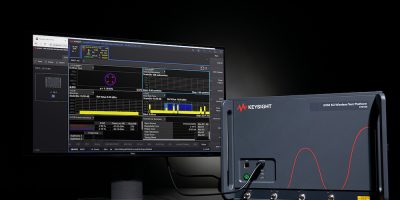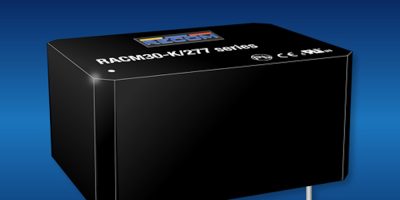Designed specifically for all cellular IoT (CIoT) technologies, including the 5G RedCap specification, the E7515R is Keysight Technologies’ wireless test platform for chipset, device and module makers. The network emulation platform supports the development workflow from early design and development to deployment, said Keysight.
The E7515R is based on the company’s 5G Network Emulation Solutions platform, a streamlined network emulator specifically designed for protocol, radio frequency (RF), and functional testing of all CIoT technologies.
The E7515R features streamlined capabilities for RedCap without the additional features needed to test a full-spec 5G device. The integrated platform combines RF, protocol, functional, and performance testing in a compact footprint.
The 5G RedCap specification introduces support for wireless devices with reduced 5G capabilities. These devices are less complex, and consume less power, allowing them to address new CIoT use cases such as industrial sensors and wearables such as smartwatches. Like other cellular devices, RedCap devices require time-consuming and expensive certification from accredited labs before they can be released to the market. By performing lab validation early, to identify and correct design issues, device and module manufacturers can shorten the certification process for RedCap and other CIoT devices, said Keysight.
The E7515R supports 5G Release 17 RedCap and legacy CIoT technologies, including Narrowband IoT (NB-IoT), LTE Category M, and LTE Cat-1bis.
The E7515R is built on the same architecture as Keysight’s 5G Network Emulation Solutions platform. The E7515R also uses the same software, providing workflow consistency and reduced learning curves.
The E7515R is shipping now and Keysight will demonstrate the solution’s 5G RedCap network emulation capabilities at MWC 2023 in Barcelona (27 February to 02 March): Hall 5 Stand 5E12.
Keysight delivers design and validation products across the development lifecycle, in design simulation, prototype validation, automated software testing, manufacturing analysis, and network performance optimisation and visibility in enterprise, service provider and cloud environments. Customers span the worldwide communications and industrial ecosystems, aerospace and defence, automotive, energy, semiconductor and general electronics markets.
Smart Cities
Recom extends board-mount AC/DC power supplies with 30W model
Low-power AC/DC power supplies from Recom now include a 30W part in a 26 x 2.0 x 2.0 inch (40 x 52.5 x 25.5mm) package.
The efficient RACM30-K/277 series provides 30W continuous power (36W peak) across an ambient range of -40 to +60 degrees C in free air and up to +90 degrees C with derating. The wide input range is 85 to 305V AC (120V to 430V DC) and regulated and fully protected outputs available are 5.0, 12, 15, 24, +/-12, and +/-15V, rated as ‘limited power source’.
The class II insulation parts are rated for harsh over-voltage category III (OVC III) and pollution degree 3 (PD3) environments up to 5000m altitude. Safety certifications include audio/video, IT, test equipment, industrial, household, and MOPP medical, with 4kVAC/1 min, rated isolation. The RACM30-K/277’s no-load / standby dissipation meets eco-design requirements with near-flat efficiency curves down to light loads, reported Recom. All parts meet Class B EMC standards with a wide margin without external components, even with grounded outputs.
The RACM30-K/277 series uses silicon-free encapsulation and is offered as a board-mount module with an industry-standard pinout. Optionally, the parts are available with flying leads or as panel-mounted with clip accessories to enable DIN-rail mounting.
Typical applications include house-keeping power in EV chargers, industrial automation, lighting, IoT, medical and smart energy systems.
Parts include a three-year warranty. Samples are available from all authorised distributors or directly from Recom.
Recom Power manufactures a range of standard and customised DC/DC and AC/DC converters in every power class from sub-1W to tens of kW. It also manufactures switching regulators and LED drivers in a wide selection of formats.
The company’s headquarters are located in Gmunden, Austria, and include a logistics research and development centre and laboratory wing. It is supported by a worldwide distribution network.
Rohde & Schwarz implements AI and ML with Nvidia at MWC
At MWC 2023 next week (27 to 02 March 2023) in Barcelona, Rohde & Shwarz will showcase the possibilities of an AI-native air interface for 6G. Working with Nvidia, it will present the industry’s first hardware-in-the-loop demonstration of a neural receiver, showing the achievable performance gains when using trained machine learning (ML) models compared to traditional signal processing.
There will be a demonstration of how a neural receiver approach performs in a 5G NR uplink multi-user multiple input multiple output (MU-MIMO) scenario, which is a blueprint for a possible 6G physical layer. The setup combines test solutions for signal generation and analysis from Rohde & Schwarz and the Nvidia Sionna GPU-accelerated open-source library for link-level simulations.
A neural receiver constitutes the concept of replacing signal processing blocks for the physical layer of a wireless communications system with trained ML models. Academia, leading research institutes and industry experts across the globe anticipate that a future 6G standard will use AI/ML for signal processing tasks, such as channel estimation, channel equalisation, and demapping. Today’s simulations suggest that a neural receiver will increase link-quality and will impact throughput compared to the current high-performance deterministic software algorithms used in 5G NR.
To train machine learning models, data sets are an absolute prerequisite. Often, the required access to data sets is limited or simply not available. In the current state of early 6G research, test and measurement equipment provides a viable alternative when generating various data sets with different signal configurations to train ML models for signal processing tasks.
In the showcased AI/ML-based neural receiver setup, the R&S SMW200A vector signal generator emulates two individual users transmitting an 80MHz wide signal in the uplink direction with a MIMO 2×2 signal configuration. Each user is independently faded, and noise is applied to simulate realistic radio channel conditions. The R&S MSR4 multi-purpose satellite receiver acts as the receiver, capturing the signal transmitted at a carrier frequency of 3GHz by using its four phase-coherent receive channels. The data is then provided via the real-time streaming interface to a server. There, the signal is pre-processed using the R&S Server-Based Testing (SBT) framework including R&S VSE vector signal explorer (VSE) micro-services. The VSE signal analysis software synchronises the signal and performs fast Fourier transforms (FFT). This post-FFT data set serves as input for a neural receiver implemented using Sionna.
Nvidia’s Sionna is a GPU-accelerated open-source library for link-level simulation. It enables rapid prototyping of complex communications system architectures and provides native support to the integration of machine learning in 6G signal processing.
As part of the demonstration, the trained neural receiver is compared to the classical concept of a linear minimum mean squared error (LMMSE) receiver architecture, which applies traditional signal processing techniques based on deterministically developed software algorithms. These already high-performance algorithms are widely adopted in current 4G and 5G cellular networks.
Rohde & Schwarz will present the AI/ML based trained neural receiver demonstration at Fira Gran Via in Barcelona, Hall 5-5A80.
Gigabyte unveils servers for HPC, 5G edge and green computing at MWC 2023
At next week’s MWC in Barcelona, Gigabyte will present 5G edge and green computing servers.
There will be a new server series aimed to deliver impact in high performance computing (HPC), AI development and cloud computing. The servers are for a academic institutions, and a variety of industries, such as aerospace centres, public cloud services, semiconductor companies and animation studios.
Gigabyte’s edge data centres will accelerate the 5G ecosystem growth, said the company. They can process data with “exceptional transmission speed and computing performance using less energy”. The short depth chassis design allows the servers to fit into limited spaces near data sources. They support a large amount of IoT devices in real time.
With growing coverage of 5G networks, smart manufacturing, automotive technology and smart cities are all driving increasing demand for edge data centres. Gigabyte said its edge servers are aimed to empower enterprises and institutes to unlock the infinite 5G-related business opportunities.
Another industry trend addresses by Gigabye is for “green” computing to boost data centre performance with a smaller carbon footprint and to contribute to meeting net zero targets. Electricity price hikes and extreme weathers make data centre cooling a critical demand in IT strategy. Gigabyte’s immersion cooling and compatible servers have been adopted by an IC foundry to improve its HPC data centre’s carbon emission and heat dissipation. Its PUE (power usage effectiveness) was significantly lowered to under 1.08 and the performance of HPC processors was boosted by over 10 per cent, reported Gigabyte.
Gigabyte has over 30 years’ of experience in motherboards and graphics cards, and provides businesses with server and data centre expertise. The company is devoted to inventing smart solutions that enable digitalisation from edge to cloud, and allow customers to capture, analyse, and transform digital information into economic data.
Visit Gigabyte at MWC 2023 (27 February to 02 March) Hall 5-5F60
About Smart Cities
This news story is brought to you by smartcitieselectronics.com, the specialist site dedicated to delivering information about what’s new in the Smart City Electronics industry, with daily news updates, new products and industry news. To stay up-to-date, register to receive our weekly newsletters and keep yourself informed on the latest technology news and new products from around the globe. Simply click this link to register here: Smart Cities Registration






